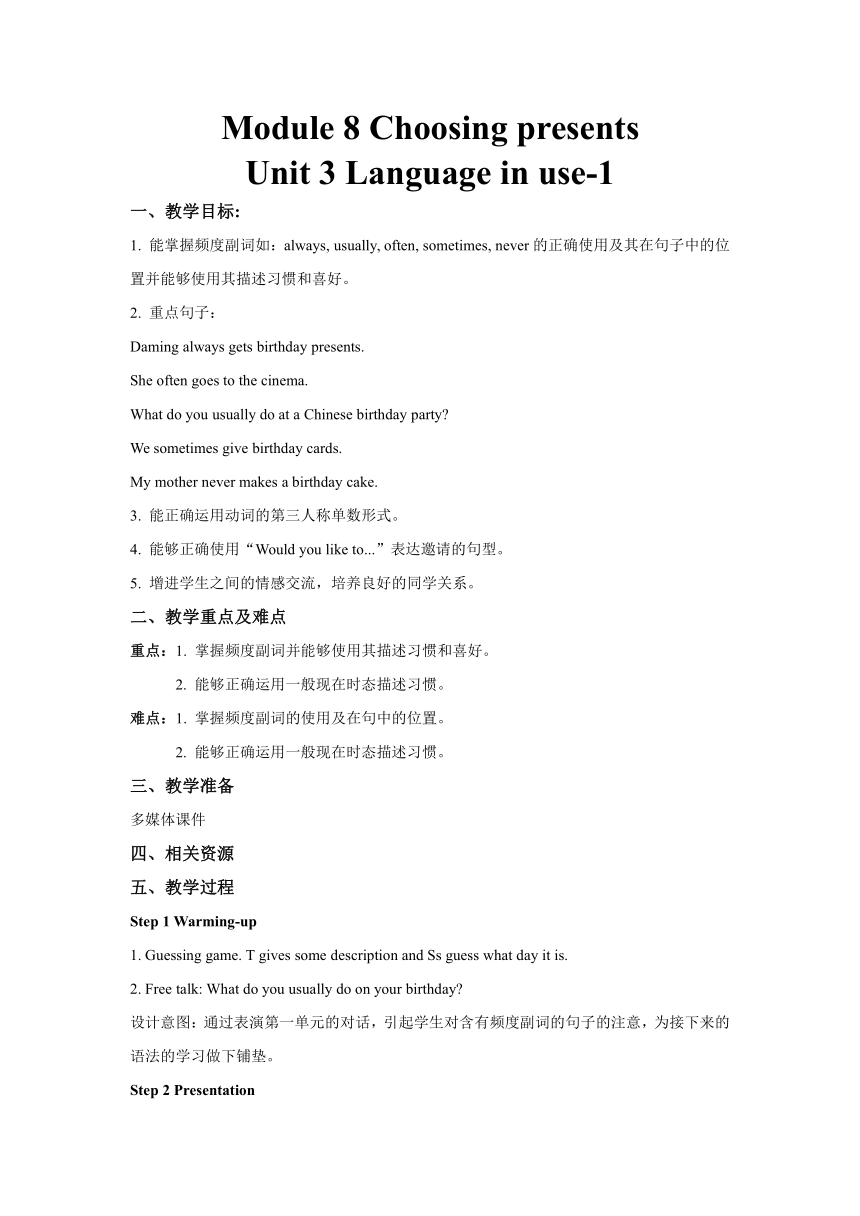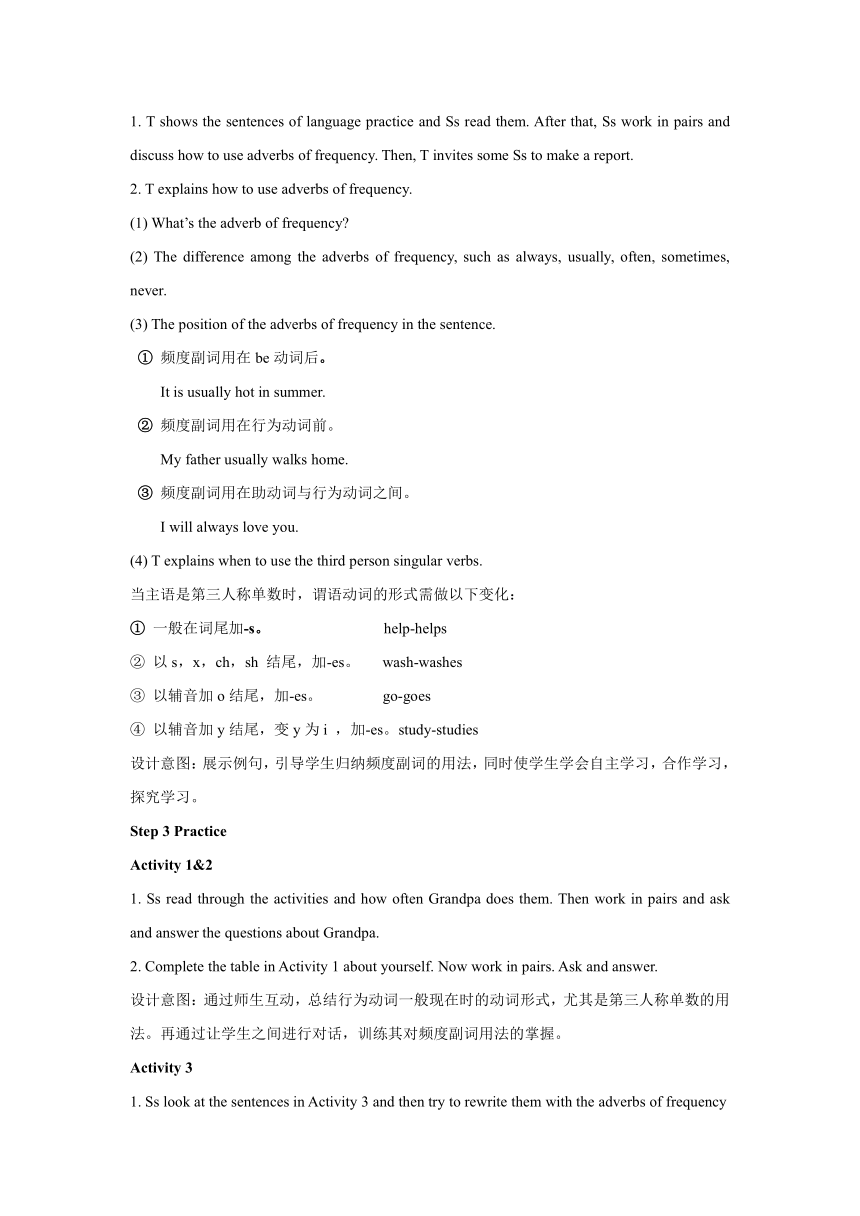外研版七年级英语上册Module 8 Choosing presents Unit 3 Language in use.教案
文档属性
| 名称 | 外研版七年级英语上册Module 8 Choosing presents Unit 3 Language in use.教案 |  | |
| 格式 | docx | ||
| 文件大小 | 19.6KB | ||
| 资源类型 | 教案 | ||
| 版本资源 | 外研版 | ||
| 科目 | 英语 | ||
| 更新时间 | 2022-10-08 16:50:28 | ||
图片预览


文档简介
Module 8 Choosing presents
Unit 3 Language in use-1
一、教学目标:
1. 能掌握频度副词如:always, usually, often, sometimes, never的正确使用及其在句子中的位置并能够使用其描述习惯和喜好。
2. 重点句子:
Daming always gets birthday presents.
She often goes to the cinema.
What do you usually do at a Chinese birthday party
We sometimes give birthday cards.
My mother never makes a birthday cake.
3. 能正确运用动词的第三人称单数形式。
4. 能够正确使用“Would you like to...”表达邀请的句型。
5. 增进学生之间的情感交流,培养良好的同学关系。
二、教学重点及难点
重点:1. 掌握频度副词并能够使用其描述习惯和喜好。
2. 能够正确运用一般现在时态描述习惯。
难点:1. 掌握频度副词的使用及在句中的位置。
2. 能够正确运用一般现在时态描述习惯。
三、教学准备
多媒体课件
四、相关资源
五、教学过程
Step 1 Warming-up
1. Guessing game. T gives some description and Ss guess what day it is.
2. Free talk: What do you usually do on your birthday
设计意图:通过表演第一单元的对话,引起学生对含有频度副词的句子的注意,为接下来的语法的学习做下铺垫。
Step 2 Presentation
1. T shows the sentences of language practice and Ss read them. After that, Ss work in pairs and discuss how to use adverbs of frequency. Then, T invites some Ss to make a report.
2. T explains how to use adverbs of frequency.
(1) What’s the adverb of frequency
(2) The difference among the adverbs of frequency, such as always, usually, often, sometimes, never.
(3) The position of the adverbs of frequency in the sentence.
① 频度副词用在be动词后。
It is usually hot in summer.
② 频度副词用在行为动词前。
My father usually walks home.
③ 频度副词用在助动词与行为动词之间。
I will always love you.
(4) T explains when to use the third person singular verbs.
当主语是第三人称单数时,谓语动词的形式需做以下变化:
① 一般在词尾加-s。 help-helps
② 以s,x,ch,sh 结尾,加-es。 wash-washes
③ 以辅音加o结尾,加-es。 go-goes
④ 以辅音加y结尾,变y为i ,加-es。study-studies
设计意图:展示例句,引导学生归纳频度副词的用法,同时使学生学会自主学习,合作学习,探究学习。
Step 3 Practice
Activity 1&2
1. Ss read through the activities and how often Grandpa does them. Then work in pairs and ask and answer the questions about Grandpa.
2. Complete the table in Activity 1 about yourself. Now work in pairs. Ask and answer.
设计意图:通过师生互动,总结行为动词一般现在时的动词形式,尤其是第三人称单数的用法。再通过让学生之间进行对话,训练其对频度副词用法的掌握。
Activity 3
1. Ss look at the sentences in Activity 3 and then try to rewrite them with the adverbs of frequency
in the brackets.
2. Ss work in pairs and check the answers with their partner.
3. T and Ss check the answers together.
设计意图:训练学生对频度副词用法的掌握。
Activity 4
1. T explains the differences between “Would you like” and “Let’s”.
2. Ss complete the sentences with “Would you like” or “Let’s”.
3. Check the answers together.
设计意图:让学生理解并掌握Would you like…用于发出邀请,Let’s…用于发出倡议。
Activity 5
1. Ss read the emails and then check the true sentences.
2. Check the answers with their partner.
3. Check the answers together.
设计意图:查看学生对频度副词的掌握程度。
Step 4 Consolidation
T lets Ss do some exercises.
1. — Can your father drive
—Yes, and he usually _____ to school.
A. drove B. is driving
C. drives D. has driven
2. We often eat dinner at home at weekends, but ______ we eat out.
A. sometimes B. seldom C. never D. always
3. Jerry _________ for school.
A. is usually late B. usually is late
C. is late usually D. goes usually late
4. — Do you often exercise, Jason
— No, _____. I don’t like sports at all.
A. always B. often
C. usually D. never
设计意图: 让学生根据提示编对话,锻炼学生利用所学语言进行有效输出。
Step 5 Summary
根据表示频率的程度从大到小可以排列为:
always (总是、一直)→ usually (通常)→ often (经常) →sometimes (有时候)→ never (从不)
设计意图:巩固所学的重点词汇及句型。
Step 6 Homework
1. Make up new sentences using the newly learnt adverbs of frequency, like: always, usually, often, sometimes, never.
2. Search on the Internet for more information about choosing presents in different countries.
六、板书设计
Unit 3 Language in use-1
根据表示频率的程度从大到小可以排列为:
always (总是、一直)→ usually (通常)→ often (经常) →sometimes (有时候)→ never (从不)
Unit 3 Language in use-1
一、教学目标:
1. 能掌握频度副词如:always, usually, often, sometimes, never的正确使用及其在句子中的位置并能够使用其描述习惯和喜好。
2. 重点句子:
Daming always gets birthday presents.
She often goes to the cinema.
What do you usually do at a Chinese birthday party
We sometimes give birthday cards.
My mother never makes a birthday cake.
3. 能正确运用动词的第三人称单数形式。
4. 能够正确使用“Would you like to...”表达邀请的句型。
5. 增进学生之间的情感交流,培养良好的同学关系。
二、教学重点及难点
重点:1. 掌握频度副词并能够使用其描述习惯和喜好。
2. 能够正确运用一般现在时态描述习惯。
难点:1. 掌握频度副词的使用及在句中的位置。
2. 能够正确运用一般现在时态描述习惯。
三、教学准备
多媒体课件
四、相关资源
五、教学过程
Step 1 Warming-up
1. Guessing game. T gives some description and Ss guess what day it is.
2. Free talk: What do you usually do on your birthday
设计意图:通过表演第一单元的对话,引起学生对含有频度副词的句子的注意,为接下来的语法的学习做下铺垫。
Step 2 Presentation
1. T shows the sentences of language practice and Ss read them. After that, Ss work in pairs and discuss how to use adverbs of frequency. Then, T invites some Ss to make a report.
2. T explains how to use adverbs of frequency.
(1) What’s the adverb of frequency
(2) The difference among the adverbs of frequency, such as always, usually, often, sometimes, never.
(3) The position of the adverbs of frequency in the sentence.
① 频度副词用在be动词后。
It is usually hot in summer.
② 频度副词用在行为动词前。
My father usually walks home.
③ 频度副词用在助动词与行为动词之间。
I will always love you.
(4) T explains when to use the third person singular verbs.
当主语是第三人称单数时,谓语动词的形式需做以下变化:
① 一般在词尾加-s。 help-helps
② 以s,x,ch,sh 结尾,加-es。 wash-washes
③ 以辅音加o结尾,加-es。 go-goes
④ 以辅音加y结尾,变y为i ,加-es。study-studies
设计意图:展示例句,引导学生归纳频度副词的用法,同时使学生学会自主学习,合作学习,探究学习。
Step 3 Practice
Activity 1&2
1. Ss read through the activities and how often Grandpa does them. Then work in pairs and ask and answer the questions about Grandpa.
2. Complete the table in Activity 1 about yourself. Now work in pairs. Ask and answer.
设计意图:通过师生互动,总结行为动词一般现在时的动词形式,尤其是第三人称单数的用法。再通过让学生之间进行对话,训练其对频度副词用法的掌握。
Activity 3
1. Ss look at the sentences in Activity 3 and then try to rewrite them with the adverbs of frequency
in the brackets.
2. Ss work in pairs and check the answers with their partner.
3. T and Ss check the answers together.
设计意图:训练学生对频度副词用法的掌握。
Activity 4
1. T explains the differences between “Would you like” and “Let’s”.
2. Ss complete the sentences with “Would you like” or “Let’s”.
3. Check the answers together.
设计意图:让学生理解并掌握Would you like…用于发出邀请,Let’s…用于发出倡议。
Activity 5
1. Ss read the emails and then check the true sentences.
2. Check the answers with their partner.
3. Check the answers together.
设计意图:查看学生对频度副词的掌握程度。
Step 4 Consolidation
T lets Ss do some exercises.
1. — Can your father drive
—Yes, and he usually _____ to school.
A. drove B. is driving
C. drives D. has driven
2. We often eat dinner at home at weekends, but ______ we eat out.
A. sometimes B. seldom C. never D. always
3. Jerry _________ for school.
A. is usually late B. usually is late
C. is late usually D. goes usually late
4. — Do you often exercise, Jason
— No, _____. I don’t like sports at all.
A. always B. often
C. usually D. never
设计意图: 让学生根据提示编对话,锻炼学生利用所学语言进行有效输出。
Step 5 Summary
根据表示频率的程度从大到小可以排列为:
always (总是、一直)→ usually (通常)→ often (经常) →sometimes (有时候)→ never (从不)
设计意图:巩固所学的重点词汇及句型。
Step 6 Homework
1. Make up new sentences using the newly learnt adverbs of frequency, like: always, usually, often, sometimes, never.
2. Search on the Internet for more information about choosing presents in different countries.
六、板书设计
Unit 3 Language in use-1
根据表示频率的程度从大到小可以排列为:
always (总是、一直)→ usually (通常)→ often (经常) →sometimes (有时候)→ never (从不)
同课章节目录
- Starte
- Module 1 My teacher and my friends
- Module 2 My English lesson
- Module 3 My English book
- Module 4 My everyday life
- Module 1 My classmates
- Unit 1 Nice to meet you.
- Unit 2 I'm Wang Lingling and I'm thirteen years ol
- Unit 3 Language in use.
- Module 2 My family
- Unit 1 Is this your mum?
- Unit 2 These are my parents.
- Unit 3 Language in use.
- Module 3 My school
- Unit 1 There are thirty students in my class.
- Unit 2 The library is on the left of the playgroun
- Unit 3 Language in use.
- Module 4 Healthy food
- Unit 1 We've got lots of apples.
- Unit 2 Is your food and drink healthy?
- Unit 3 Language in use.
- Module 5 My school day
- Unit 1 I love history.
- Unit 2 We start work at nine o'clock.
- Unit 3 Language in use.
- Revision module A
- Module 6 A trip to the zoo
- Unit 1 Does it eat meat?
- Unit 2 The tiger lives in Asia.
- Unit 3 Language in use.
- Module 7 Computers
- Unit 1 How do I write my homework on the computer?
- Unit 2 When do you use a computer?
- Unit 3 Language in use.
- Module 8 Choosing presents
- Unit 1 I always like birthday parties.
- Unit 2 She often goes to concerts.
- Unit 3 Language in use.
- Module 9 People and places
- Unit 1 We're enjoying the school trip a lot.
- Unit 2 They're waiting for buses or trains.
- Unit 3 Language in use.
- Module 10 Spring Festival
- Unit 1 Are you getting ready for Spring Festival?
- Unit 2 My mother's cleaning our houses and sweepin
- Unit 3 Language in use.
- Revision module B
